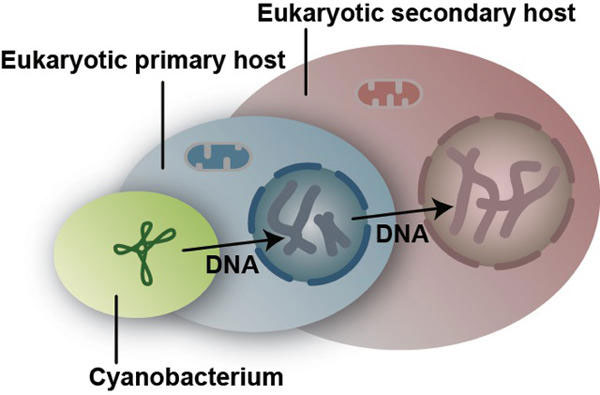Discovered mechanisms for plants to have four different genotypes
One of the first chemical reactions that children are known for is photosynthetic reactions, combining carbon dioxide, water and solar energy to produce organic compounds.
Many of the plants around the world have the most important humanity in the world, as plants have not developed the ability to incorporate these ingredients. Instead, they take their chloroplasts indirectly by "stealing" them from other organisms.
In some cases, this makes the algae have a diverse and different set of genes, the evolution equivalent to that of a 'turducken' (turducken is a seasonal dish including: a boneless chicken stuffed into one The bone-drawn duck, which is itself stuffed into a boneless turkey.

The chloroplast was originally developed from photosynthetic bacteria by primary symbiosis, in which a bacterium or other primitive nucleus plants are embedded deep inside by a typical nucleus host. The chloroplasts of red and green algae then came to reside in other host plants, plants that had no previous photosynthetic nuclei with secondary symbiosis. These events have contributed to the global diversity of photosynthetic organisms that play a very important role in regulating and maintaining the global carbon cycle.
In most organisms that are photosynthesized by this mechanism, the kernels from digested algae cells have disappeared, but in some cases it remains as a remaining organ known as a nucleomorph (the nucleus of symbiosis in maximum collapsed form). Such creatures have four different sets of genes.
To better understand secondary symbiosis and why nucleomorphs persist in some organisms, an international team of 73 researchers at 27 research institutions, including DOE JGI (US Department of Energy Joint Genome Institute), has sequenced and analyzed the genome and transcription of two small algae. The team led by John Archibald from Canada's Dalhousie University published their findings in the journal Nature today November 29, 2012. t
- 9 mechanisms of plant protection
- Virgin trees have unusual intelligence
- Mechanism to adapt to cold temperatures of plants
- Close-up of the spiders' abnormal self-defense mechanism
- Plants can hear sounds when they are eaten
- A series of 'hearing is nausea' defense mechanisms of animals
- Species protect themselves when bitten
- Nitrogen fixation: relationship between plants and bacteria (Part 2)
- Detecting mechanisms to inhibit food allergies
- Sunlight plants parasitize on mushrooms
- Discover scary carnivorous plants in Canada
- Discover mechanisms to help plants survive in extreme weather
 Why do potatoes have eyes?
Why do potatoes have eyes? 'Tragedy' the world's largest carnivorous life: Death becomes ... public toilet
'Tragedy' the world's largest carnivorous life: Death becomes ... public toilet Tomatoes were once considered 'poisonous' for 200 years
Tomatoes were once considered 'poisonous' for 200 years Detecting microscopic parasites on human face
Detecting microscopic parasites on human face